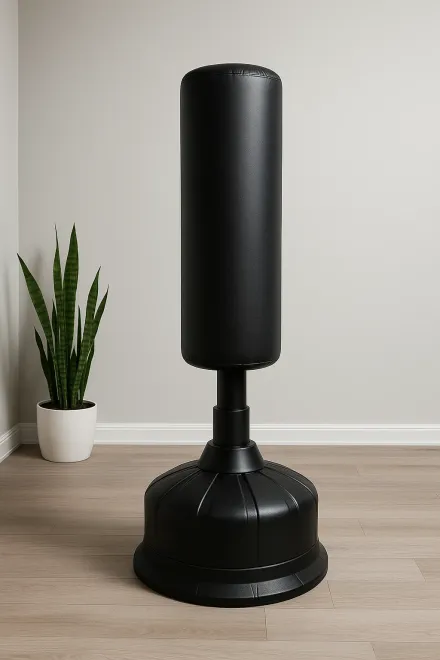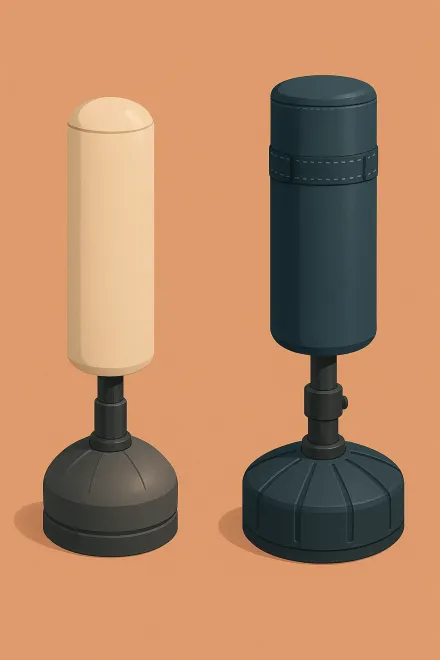Floor Boxing Bags
Floor boxing bags have become one of the most practical and versatile alternatives for training at home, in the gym, or even in tight spaces. Unlike traditional hanging bags, these models don’t require ceiling installation or special mounts, since they use a stable base filled with water or sand to stay firm during training. They are ideal for beginners and advanced practitioners alike, because they help improve technique, build endurance, relieve stress, and train safely. In this guide, you’ll find all the information you need to choose the perfect floor bag for your needs.
See floor boxing bags on Amazon
Benefits of training with a floor boxing bag
The floor boxing bag offers several advantages over traditional hanging models. First, installation is much simpler, since you don’t need to drill ceilings or assemble extra structures. Just fill the base with water or sand to achieve the required stability. They are also easy to move from place to place, which is very useful in homes with limited space.
Another key advantage is that they let you work both upper and lower body. With adjustable height on some models and a bit of movement on impact, they promote reflex and coordination training. They are perfect for recreational boxing sessions, fitness, kickboxing, muay thai, or mixed martial arts.
Finally, floor bags are quieter and safer than hanging ones, because they absorb strikes better without excessive vibrations or annoying noise. For all these reasons, they have become the preferred choice for those who want to train efficiently at home.
How to choose the right floor boxing bag
Your choice of floor boxing bag will depend on several important factors. First, consider the type of training you’ll do. If you’ll only use it for fitness or cardio, you can opt for lighter, more affordable models. If you’ll use it for intensive boxing, kickboxing, or martial arts, it’s better to choose a robust, highly durable model.
Another key aspect is the material. Quality bags are usually made from reinforced synthetic leather or heavy-duty vinyl, which ensures durability and wear resistance. The base is also critical: the larger and heavier it is, the more stability it provides. Remember that you can fill it with sand for greater firmness, while water makes it easier to move.
It’s also worth checking the bag’s height. There are adjustable models, which is a major advantage if several people of different heights will use it. Finally, don’t forget to verify whether it includes adequate internal cushioning, as this not only extends the bag’s lifespan but also protects your hands and joints during training.


Best workouts with a floor boxing bag
The floor boxing bag is a very versatile tool that enables complete training for both technique and endurance. Recommended exercises include combinations of basic punches such as jab, cross, hook, and uppercut, which help improve precision and speed. You can also integrate front, round, and side kicks for kickboxing or muay thai.
A highly effective routine is to perform timed rounds of 2 to 3 minutes with 30 seconds of rest, mimicking the pace of a real bout. This improves cardiovascular endurance, coordination, and explosive power. In addition, you can add footwork around the bag to work on mobility and defensive reflexes.
Another interesting option is to use the bag within functional training circuits. For example, combine 1 minute of strikes with push-ups, burpees, or squats, achieving a full-body workout. This versatility makes floor bags indispensable for any athlete looking to improve overall fitness in a comprehensive way.
Maintenance tips for your floor boxing bag
Caring for your floor boxing bag is essential to extend its lifespan and ensure safe training. First, it’s advisable to wipe the surface after each use with a damp cloth to remove sweat and dust. If the material is synthetic leather, you can occasionally apply specialty products to keep flexibility and prevent cracking.
Another important point is to check the base regularly. If you fill it with water, make sure there are no leaks and change it periodically to avoid bad odors. If you use sand, ensure it’s well compacted to prevent unnecessary movement during strikes. Keeping the base in good condition is key for the bag’s stability and safety.
Also inspect the internal cushioning. Over time and frequent use, filling materials can lose consistency. If you notice sunken or uneven areas, it’s advisable to redistribute the material or even replace it if the manufacturer allows. This not only improves the striking feel but also protects your hands.
Finally, place the bag in a ventilated location and avoid direct sun exposure, since extreme heat can damage materials. With these simple steps, your floor boxing bag will remain in top condition for much longer, delivering safe and effective workouts.
Common mistakes when training with a floor boxing bag
While the floor boxing bag is an excellent tool, many users make mistakes that limit its benefits or even cause injuries. One of the most frequent is striking without proper technique. Although the bag doesn’t demand an advanced level, it’s important to maintain good posture, use gloves and wraps, and punch with correct body rotation to avoid wrist and shoulder issues.
Another common mistake is training without a plan. Many people hit the bag randomly without a clear goal. To get real results, it’s best to design structured routines with work rounds, rest periods, and punch combinations. This not only improves fitness but also discipline and technique.
You should also avoid overloading the base with too much sand or water, as disproportionate weight can damage the bag or hinder mobility. Likewise, training too close to the bag without footwork limits real-fight experience, so practice lateral movement and defensive actions.
Lastly, a common error is not using the bag within a broader program. The bag is a great tool, but it should be combined with strength, cardio, and technical work. This way you achieve balanced, sustainable progress. Avoiding these mistakes will make your sessions more productive, safe, and effective.
Frequently asked questions about floor boxing bags
What’s the difference between a floor boxing bag and a hanging one?
The main difference is installation. A hanging bag needs a fixed ceiling or wall mount, while a floor bag has a base filled with water or sand to stabilize it. The floor bag is more practical and easier to move, ideal for training at home without complex installations. However, a hanging bag usually offers a feel closer to a real fight thanks to its natural swing. The choice depends on available space, training intensity, and user preferences.
Which is better, filling the base with water or sand?
Both options work, but they differ. Water lets you move the bag more easily by emptying it, while sand provides greater stability because it’s heavier. If you want the bag to stay firmly in place during intense sessions, sand is best. If you need to move it often, water is more convenient. Many users even combine both materials to balance stability and mobility.
Is a floor boxing bag suitable for beginners?
Yes, floor boxing bags are perfect for beginners because they don’t require complex setup and offer a broad, stable surface for practice. They also help you develop basic punching and kicking technique without a coach. For newcomers, it’s best to start with short sessions of 2 to 3 rounds of light strikes, prioritizing technique over power. This reduces injury risk and enables gradual progress.
What height should a floor boxing bag have?
The ideal height depends on your stature and training style. In general, a bag from 1.60 m to 1.80 m suits most adults, since it allows both high punches and mid to low kicks. Some models offer adjustable height, which is very practical if people of different sizes will use it. The most important thing is that the bag sits at a comfortable, natural striking height.
How long does a floor boxing bag last?
A floor bag’s durability depends on material quality and the care it receives. A good brand model made of reinforced synthetic leather or vinyl can last several years with regular use. It’s important to clean it after workouts, protect it from direct sun, and periodically check the base and filling. With proper maintenance, a floor bag can accompany you for many years of practice.
Can a floor boxing bag be used for kickboxing or muay thai?
Yes, they are highly recommended for these disciplines, since they allow training punches and kicks at different heights. Their stable yet slightly mobile design helps simulate an opponent’s response. However, it’s important to choose a sturdy model with a solid base to withstand the intensity of kicks and knees. This ensures safer, more realistic training, especially for full-contact martial arts.
Can I use a floor boxing bag in an apartment without disturbing neighbors?
In most cases yes, because floor bags are quieter than hanging ones. As they aren’t fixed to ceiling or wall, they don’t transmit vibrations. Many models also have rubber bases that reduce impact noise. If you live in a place with thin floors, place a mat under the bag to further minimize noise and protect the floor. This way you can train without bothering neighbors.
